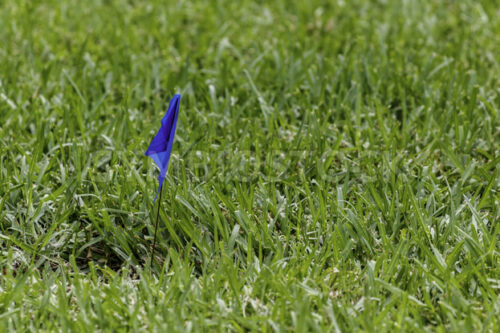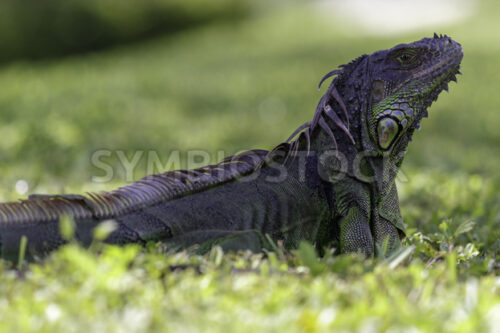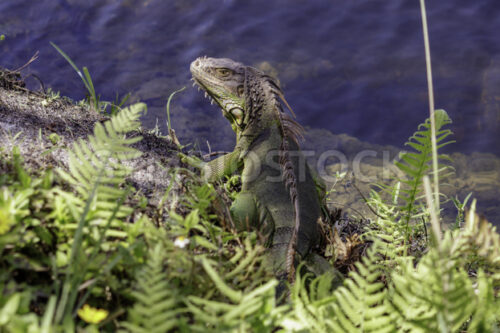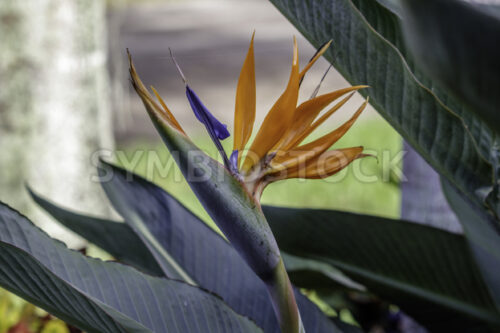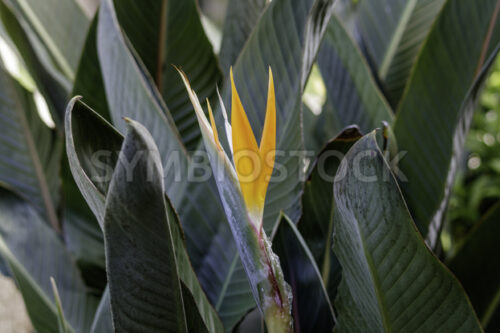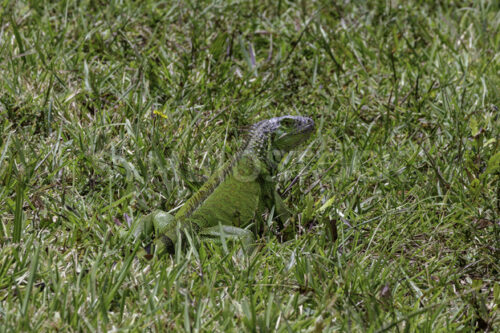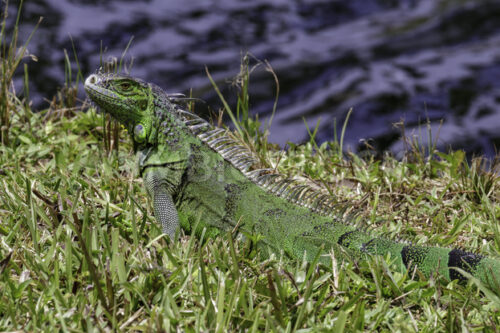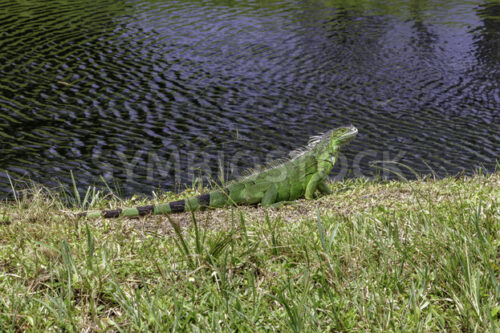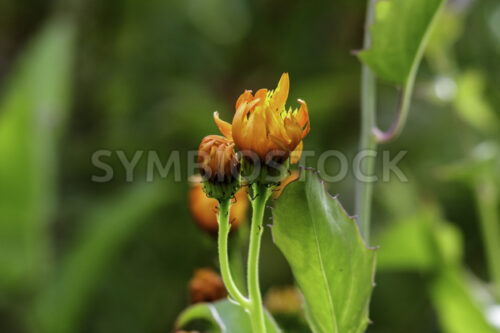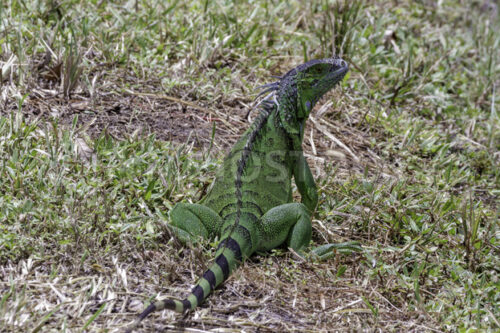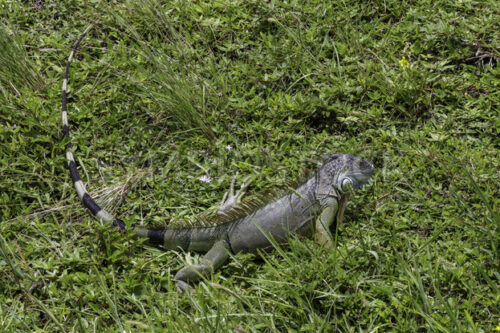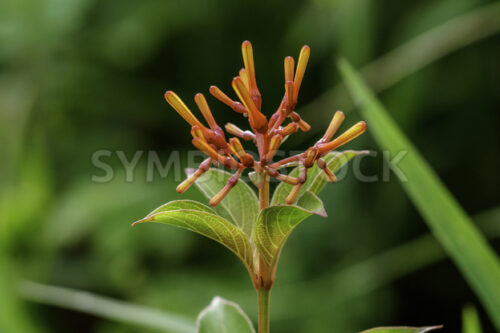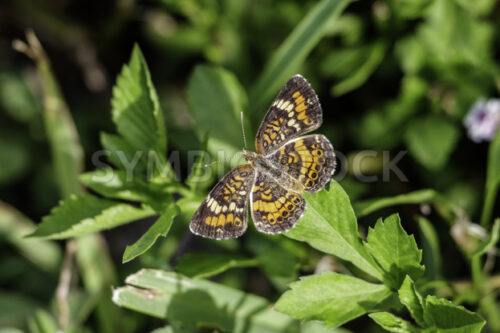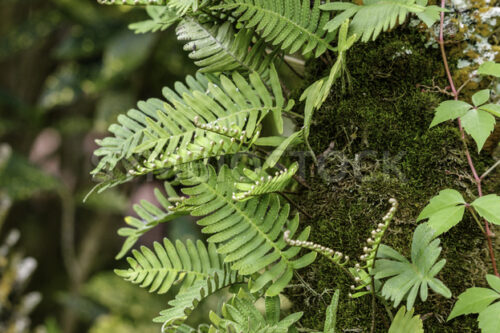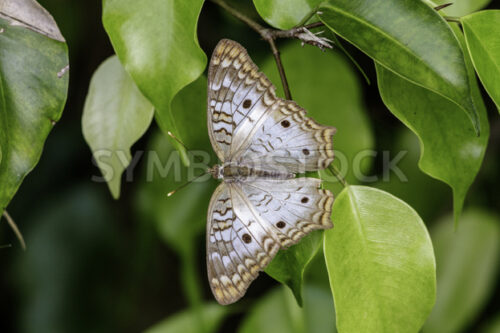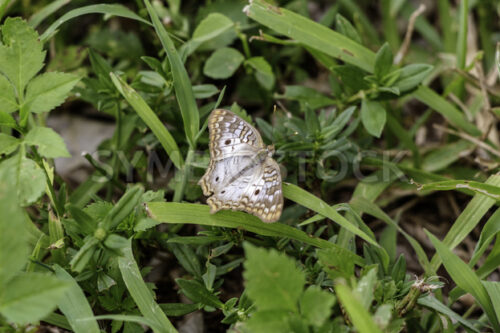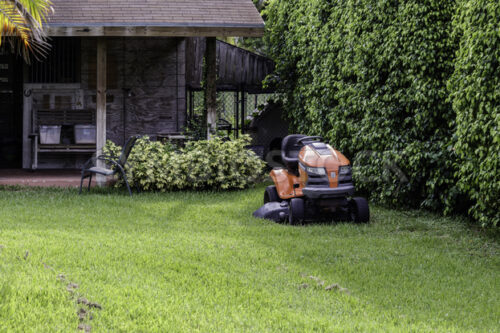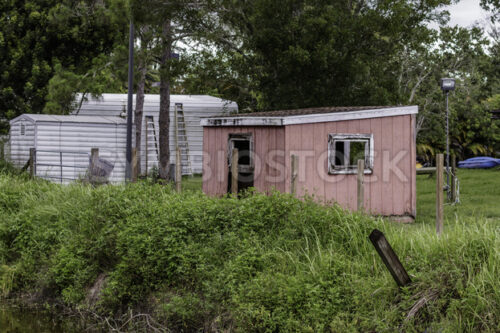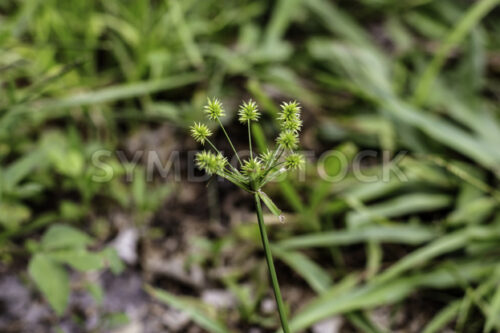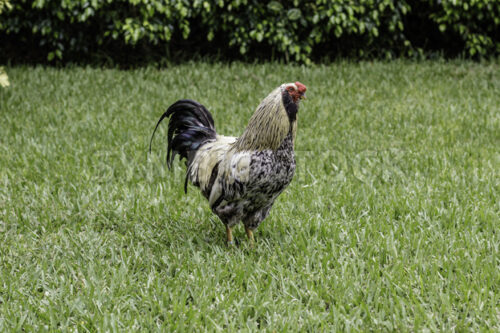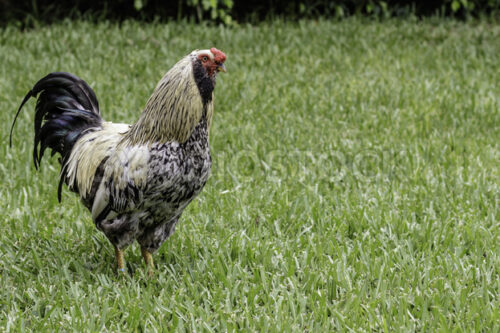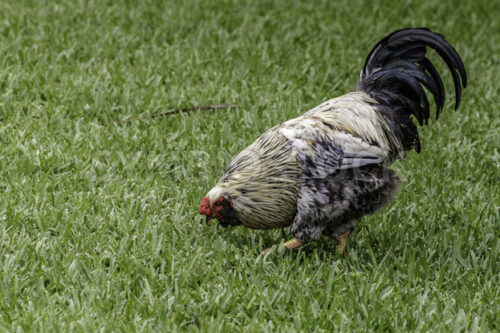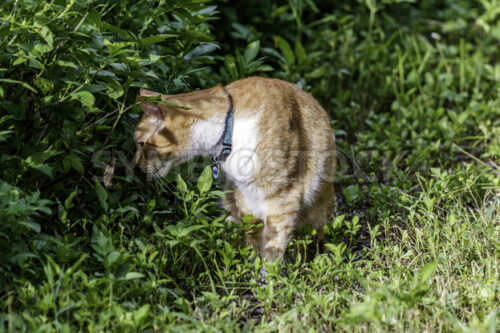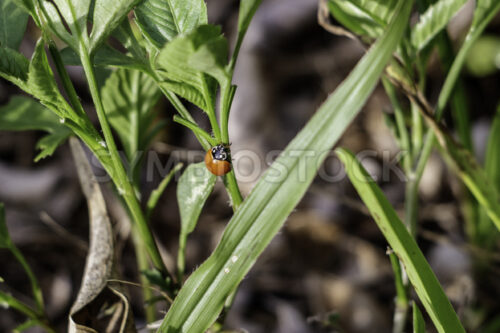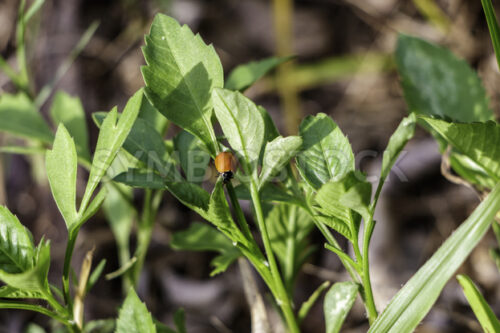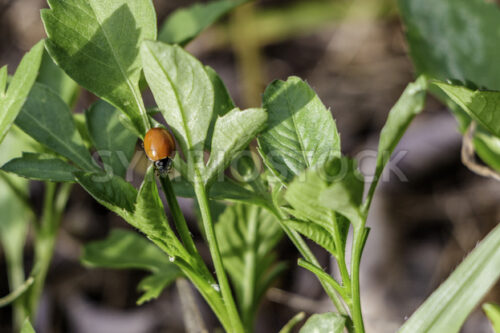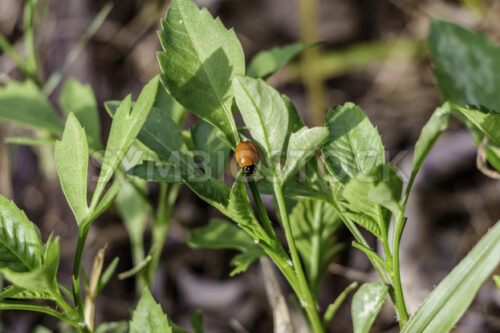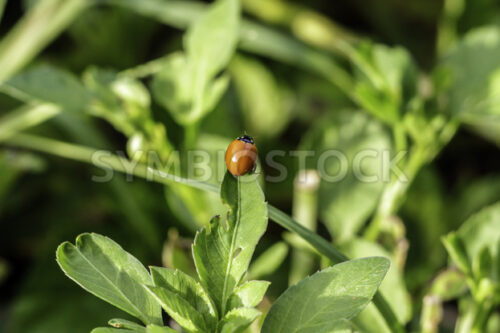- Sale!Close up of blue sprinkler marker in Floratam brand St. Augustine grass developed in the 1970's by the University of Florida.St. Augustine grass (Stenotaphrum secundatum) is a water-efficient turf grass used in many warm-season lawns. Several types of St. Augustine are available for lawns, but one of the most popular is 'Floratam' (Stenotaphrum secundatum 'Floratam'). Since its introduction by the University of Florida and Texas A & M University in 1973, this variety has become one of the most produced and prevalent St. Augustine grasses used in warm-season lawns.St. Augustine grass is a warm-season grass that is hardy in U.S. Department of Agriculture plant hardiness zones 8 through 10. This broad-bladed, medium-green turf grass thrives in sunny locations, but unlike some sun-loving grasses, it also has a high shade tolerance. Common St. Augustine grass grows quickly during summer, but more slowly in fall and spring. It is a salt- and drought-tolerant grass that requires moderate maintenance.Like most St. Augustine grasses, Floratam is coarse-textured grass, but a distinguishing feature of Floratam is its longer and wider leaf blades. This dark-green cultivar grows rapidly in both spring and summer. It is less cold and shade tolerant than other St. Augustine grass cultivars and can suffer from freeze damage when temperatures stay below freezing for an extended period of time; it is hardy only in USDA zones 9 and 10. Floratam needs plenty of sunshine and will perform poorly if it receives less than six hours of sunlight a day.Floratam can be established by sod, sprigs or plugs. For the first seven to 10 days after planting, water grass several times a day for five to 10 minutes. Established Floratam should be cut to a height of 3 1/2 to 4 inches, watered 1 inch weekly and fertilized every four to eight weeks with 1/2 to 1 pound nitrogen per 1,000 square feet. Do not over-water or overfeed - use less than 4 pounds of nitrogen per 1,000 square feet annually - as this leads to thatch buildup. When mowing, be careful not to scalp the grass, cutting it low enough to expose the dirt, because weeds can establish in the damaged area.When Floratam was first introduced, it was chinch bug resistant – the most common pest problem that plagues St. Augustine grasses. Over time, though, this attribute lessened. You will know if your lawn is afflicted with chinch bugs if yellow-to-brown patches exist in the turf. It normally appears first in water-stressed areas of the lawn or near sidewalks. If chinch bugs are a significant problem, your lawn may need to be treated with an insecticide.
- Sale!Broward County and all of South Florida including Miami-Dade County, Palm Beach County and Monroe County have a huge problem of these non-native and very invasive Green Iguanas. While they are typically only plant eating, (i.e. Hibiscus flowers) they have no natural predator to keep them in check within the food chain. Populating near waterways, they are breeding and becoming larger in numbers each year. Problems include damaged vegetation, residential home intrusion and damage to property with their high acidic faecal matter. Homeowners have been hiring pest removal services, reporting them to their local municipalities and have even gone to the extreme of killing these lizard on their own. The Green Iguana can grow quite large when unchecked by nature and an endless source of food, most local residents consider them pests and unwanted inhabitants to their yards and would like to see them gone. This is an invasive non-native Lesser Antillean Green Iguana type plant eating lizard in the grass and weeds near a drainage canal by Broward Boulevard and University. They have become a common sight between the Everglades and intercoastal in South Florida near Miami Dade & Palm Beach County.
- Sale!Invasive non-native Lesser Antillean Green Iguana lizard in the grass near a drainage canal by the road between the Everglades and intercoastal in South Florida near Miami Dade & Palm Beach County. Broward County and all of South Florida including Miami-Dade County, Palm Beach County and Monroe County have a huge problem of these non-native and very invasive Green Iguanas. While they are typically only plant eating, (i.e. Hibiscus flowers) they have no natural predator to keep them in check within the food chain. Populating near waterways, they are breeding and becoming larger in numbers each year. Problems include damaged vegetation, residential home intrusion and damage to property with their high acidic faecal matter. Homeowners have been hiring pest removal services, reporting them to their local municipalities and have even gone to the extreme of killing these lizard on their own. The Green Iguana can grow quite large when unchecked by nature and an endless source of food, most local residents consider them pests and unwanted inhabitants to their yards and would like to see them gone.
- Sale!Strelitzia perennial plant, native to South Africa. Bird of Paradise named after the duchy of Mecklenburg-Strelitz. This Crane Flower Plant version is found in Coral Springs, Broward County Florida.
- Sale!Strelitzia perennial plant, native to South Africa. Bird of Paradise named after the duchy of Mecklenburg-Strelitz. This Crane Flower Plant version is found in Coral Springs, Broward County Florida
- Sale!Strelitzia perennial plant, native to South Africa. Bird of Paradise named after the duchy of Mecklenburg-Strelitz. This Crane Flower Plant version is found in Coral Springs, Broward County Florida
- Sale!Broward County and all of South Florida including Miami-Dade County, Palm Beach County and Monroe County have a huge problem of these non-native and very invasive Green Iguanas. While they are typically only plant eating, (i.e. Hibiscus flowers) they have no natural predator to keep them in check within the food chain. Populating near waterways, they are breeding and becoming larger in numbers each year. Problems include damaged vegetation, residential home intrusion and damage to property with their high acidic faecal matter. Homeowners have been hiring pest removal services, reporting them to their local municipalities and have even gone to the extreme of killing these lizard on their own. The Green Iguana can grow quite large when unchecked by nature and an endless source of food, most local residents consider them pests and unwanted inhabitants to their yards and would like to see them gone. Invasive non-native Green Iguana lizard in the grass near brackish rainwater runoff and drainage canal between the Everglades and intercoastal in South Florida near Fort Lauderdale, Broward County. Actually found near the Arby’s off of University drive in Plantation between the road and the parking lot swale area.
- Sale!Broward County and all of South Florida including Miami-Dade County, Palm Beach County and Monroe County have a huge problem of these non-native and very invasive Green Iguanas. While they are typically only plant eating, (i.e. Hibiscus flowers) they have no natural predator to keep them in check within the food chain. Populating near waterways, they are breeding and becoming larger in numbers each year. Problems include damaged vegetation, residential home intrusion and damage to property with their high acidic faecal matter. Homeowners have been hiring pest removal services, reporting them to their local municipalities and have even gone to the extreme of killing these lizard on their own. The Green Iguana can grow quite large when unchecked by nature and an endless source of food, most local residents consider them pests and unwanted inhabitants to their yards and would like to see them gone. Invasive non-native Green Iguana lizard in the grass near brackish rainwater runoff and drainage canal between the Everglades and intercoastal in South Florida near Fort Lauderdale, Broward County. Actually found near the Arby’s off of University drive in Plantation between the road and the parking lot swale area.
- Sale!Broward County and all of South Florida including Miami-Dade County, Palm Beach County and Monroe County have a huge problem of these non-native and very invasive Green Iguanas. While they are typically only plant eating, (i.e. Hibiscus flowers) they have no natural predator to keep them in check within the food chain. Populating near waterways, they are breeding and becoming larger in numbers each year. Problems include damaged vegetation, residential home intrusion and damage to property with their high acidic faecal matter. Homeowners have been hiring pest removal services, reporting them to their local municipalities and have even gone to the extreme of killing these lizard on their own. The Green Iguana can grow quite large when unchecked by nature and an endless source of food, most local residents consider them pests and unwanted inhabitants to their yards and would like to see them gone. Invasive non-native Green Iguana lizard in the grass near brackish rainwater runoff and drainage canal between the Everglades and intercoastal in South Florida near Fort Lauderdale, Broward County. Actually found near the Arby’s off of University drive in Plantation between the road and the parking lot swale area.
- Sale!Broward County and all of South Florida including Miami-Dade County, Palm Beach County and Monroe County have a huge problem of these non-native and very invasive Green Iguanas. While they are typically only plant eating, (i.e. Hibiscus flowers) they have no natural predator to keep them in check within the food chain. Populating near waterways, they are breeding and becoming larger in numbers each year. Problems include damaged vegetation, residential home intrusion and damage to property with their high acidic faecal matter. Homeowners have been hiring pest removal services, reporting them to their local municipalities and have even gone to the extreme of killing these lizard on their own. The Green Iguana can grow quite large when unchecked by nature and an endless source of food, most local residents consider them pests and unwanted inhabitants to their yards and would like to see them gone. Invasive non-native Green Iguana lizard in the grass near brackish rainwater runoff and drainage canal between the Everglades and intercoastal in South Florida near Fort Lauderdale, Broward County. Actually found near the Arby’s off of University drive in Plantation between the road and the parking lot swale area.
- Sale!Milkweed aka Asclepias is a herbaceous perennial flowering plant named for its milky latex substance for cardiac glycosides. Found in south Florida near the Everglades and Miami Dade County. Monarch caterpillars eat milkweed. In fact, the monarch butterfly is also known as the “milkweed butterfly.” The milkweed plant provides all the nourishment the monarch needs to transform the Monarch caterpillar into the adult butterfly. But these plants are rapidly disappearing, due to the loss of habitat stemming from land development and the widespread spraying of weed killer on the fields where they live.
- Sale!Broward County and all of South Florida including Miami-Dade County, Palm Beach County and Monroe County have a huge problem of these non-native and very invasive Green Iguanas. While they are typically only plant eating, (i.e. Hibiscus flowers) they have no natural predator to keep them in check within the food chain. Populating near waterways, they are breeding and becoming larger in numbers each year. Problems include damaged vegetation, residential home intrusion and damage to property with their high acidic faecal matter. Homeowners have been hiring pest removal services, reporting them to their local municipalities and have even gone to the extreme of killing these lizard on their own. The Green Iguana can grow quite large when unchecked by nature and an endless source of food, most local residents consider them pests and unwanted inhabitants to their yards and would like to see them gone. Invasive non-native Green Iguana lizard in the grass near brackish rainwater runoff and drainage canal between the Everglades and intercoastal in South Florida near Fort Lauderdale, Broward County. Actually found near the Arby’s off of University drive in Plantation between the road and the parking lot swale area.
- Sale!Broward County and all of South Florida including Miami-Dade County, Palm Beach County and Monroe County have a huge problem of these non-native and very invasive Green Iguanas. While they are typically only plant eating, (i.e. Hibiscus flowers) they have no natural predator to keep them in check within the food chain. Populating near waterways, they are breeding and becoming larger in numbers each year. Problems include damaged vegetation, residential home intrusion and damage to property with their high acidic faecal matter. Homeowners have been hiring pest removal services, reporting them to their local municipalities and have even gone to the extreme of killing these lizard on their own. The Green Iguana can grow quite large when unchecked by nature and an endless source of food, most local residents consider them pests and unwanted inhabitants to their yards and would like to see them gone. Invasive non-native Green Iguana lizard in the grass near brackish rainwater runoff and drainage canal between the Everglades and intercoastal in South Florida near Fort Lauderdale, Broward County. Actually found near the Arby’s off of University drive in Plantation between the road and the parking lot swale area.
- Sale!Broward County and all of South Florida including Miami-Dade County, Palm Beach County and Monroe County have a huge problem of these non-native and very invasive Green Iguanas. While they are typically only plant eating, (i.e. Hibiscus flowers) they have no natural predator to keep them in check within the food chain. Populating near waterways, they are breeding and becoming larger in numbers each year. Problems include damaged vegetation, residential home intrusion and damage to property with their high acidic faecal matter. Homeowners have been hiring pest removal services, reporting them to their local municipalities and have even gone to the extreme of killing these lizard on their own. The Green Iguana can grow quite large when unchecked by nature and an endless source of food, most local residents consider them pests and unwanted inhabitants to their yards and would like to see them gone. Invasive non-native Green Iguana lizard in the grass near brackish rainwater runoff and drainage canal between the Everglades and intercoastal in South Florida near Fort Lauderdale, Broward County. Actually found near the Arby’s off of University drive in Plantation between the road and the parking lot swale area.
- Sale!Invasive non-native Green Iguana lizard in the grass near brackish rainwater runoff and drainage canal between the Everglades and intercoastal in South Florida near Fort Lauderdale, Broward County. Actually found near the Arby's off of University drive in Plantation between the road and the parking lot swale area.
- Sale!Hamelia patens perennial shrub or small tree in the coffee family, Rubiaceae is native to the American subtropics and tropics. This Firebush was found in South Florida calling butterflies and bees.
- Sale!The Gulf fritillary or passion butterfly is bright orange subfamily Heliconiinae of family Nymphalidae. Agraulis vanillae was found Palm Beach county Florida near Everglades, Miami, Ft. Lauderdale. This is a small fast moving butterfly that is native to South Florida and is considered a non-invasive insect.
- Sale!Pleopeltis polypodioides aka Resurrection fern typically grows out of live oak trees, epiphytic, with moss and other vines up close. Found in south Florida near the Everglades, Miami & Palm Beach.
- Sale!Yellow Nutsedge aka Cyperus esculentus sedge family is a widespread weed found along water edges and wet areas of lawns that can overtake St. Augustine and Bermuda grass yards areas in South Florida in Loxahatchee Palm Beach County.
- Sale!Sussex Rooster on a backyard farm. This Cock of the Walk Rooster is the type of chicken known for being highly dignified and handsome. Not a native to South Florida but a great bird for its temperament. It is domesticated and cannot survive in the wild, so it is not considered an invasive species.
- Sale!Sussex Rooster on a backyard farm. This Cock of the Walk Rooster is the type of chicken known for being highly dignified and handsome. Not a native to South Florida but a great bird for its temperament. It is domesticated and cannot survive in the wild, so it is not considered an invasive species.
- Sale!Sussex Rooster on a backyard farm. This Cock of the Walk Rooster is the type of chicken known for being highly dignified and handsome. Not a native to South Florida but a great bird for its temperament. It is domesticated and cannot survive in the wild, so it is not considered an invasive species.
- Sale!Sussex Rooster on a backyard farm. This Cock of the Walk Rooster is the type of chicken known for being highly dignified and handsome. Not a native to South Florida but a great bird for its temperament. It is domesticated and cannot survive in the wild, so it is not considered an invasive species.
- Sale!A golden yellow and white tiger striped American / European shorthair aka FIFe or WCF adult domestic pet cat which originated in Sweden with a tag and color hunting in the grass near some weeds.
- Sale!This is a native Cycloneda munda ladybug, not the Asian lady beetle which bites and is an invasive species. This harmless South Florida local eats aphids and is a natural insecticide control of harmful bugs. Found in Loxahatchee Florida which is an unincorporated area of Palm Beach County. Next to Broward County the city of Fort Lauderdale and North of Miami-Dade County and Miami Beach.
- Sale!This is a native Cycloneda munda ladybug, not the Asian lady beetle which bites and is an invasive species. This harmless South Florida local eats aphids and is a natural insecticide control of harmful bugs. Found in Loxahatchee Florida which is an unincorporated area of Palm Beach County. Next to Broward County the city of Fort Lauderdale and North of Miami-Dade County and Miami Beach.
- Sale!This is a native Cycloneda munda ladybug, not the Asian lady beetle which bites and is an invasive species. This harmless South Florida local eats aphids and is a natural insecticide control of harmful bugs. Found in Loxahatchee Florida which is an unincorporated area of Palm Beach County. Next to Broward County the city of Fort Lauderdale and North of Miami-Dade County and Miami Beach.
- Sale!This is a native Cycloneda munda ladybug, not the Asian lady beetle which bites and is an invasive species. This harmless South Florida local eats aphids and is a natural insecticide control of harmful bugs. Found in Loxahatchee Florida which is an unincorporated area of Palm Beach County. Next to Broward County the city of Fort Lauderdale and North of Miami-Dade County and Miami Beach.
- Sale!This is a native Cycloneda munda ladybug, not the Asian lady beetle which bites and is an invasive species. This harmless South Florida local eats aphids and is a natural insecticide control of harmful bugs. Found in Loxahatchee Florida which is an unincorporated area of Palm Beach County. Next to Broward County the city of Fort Lauderdale and North of Miami-Dade County and Miami Beach.



